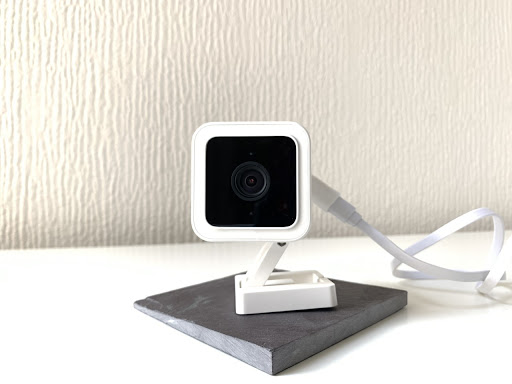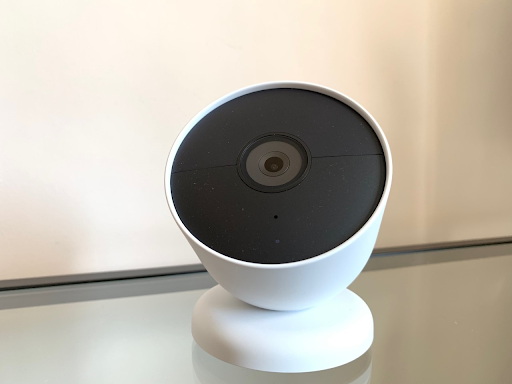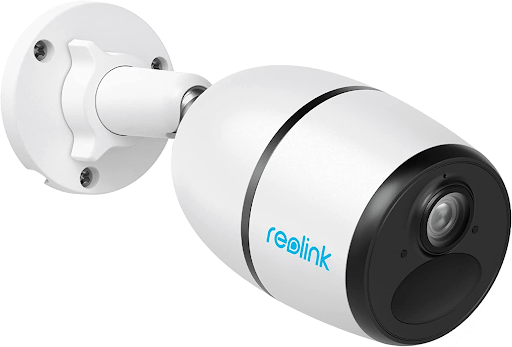Because the only way to reliably monitor outdoor areas prone to rainfall, snowfall, and humidity is to use a device that has undergone proper ingress testing, outdoor security cameras and weatherproof security cameras are essentially one-in-the-same.
The best outdoor security cameras are ones that, aside from having key features like night vision, aren’t susceptible to water or dust damage. Read on to discover the best outdoor security cameras of 2024 that are perfect for 24/7 surveillance, whatever the weather.
A word on ingress protection…
An IP, or ‘ingress protection’, rating is an international standard used to indicate how resistant a product is to solids and water. It expresses specific information determined through testing. Find out more about the rating system.
Best Weatherproof Security Cameras: Our Top Picks for 2024
- Best weatherproof wireless security camera – Arlo Pro 5
- Best cheap outdoor security camera – Wyze Cam v3
- Best battery powered weatherproof security camera – Nest Cam (battery)
- Best weatherproof security camera no Wi-Fi – Reolink Go Plus
Arlo Pro 5S 2K
Best weatherproof wireless security camera
Available from Arlo and BestBuy. From $249.99.

Pros
- UV and weather resistant
- Super crisp 2K video
- Super wide 160 degree field of view, with up to 12x digital zoom
Cons
- Expensive
- Improvements over the Pro 4 may not be enough to warrant spending 50 bucks extra
The Arlo Pro 5S is a brand new wireless rechargeable camera that supports up to 2K video with HDR. Its weather resistance makes it suitable for indoor and outdoor usage alike, but outdoors is where it truly shines thanks to the discreet spotlight and night vision.
The Pro 5S adds 12x zoom and an impressively wide 160 degree field of view, which makes it one of the most robust outdoor security cameras on the market. If neither of those things is of interest, opt for its predecessor, the Pro 4, and save 50 bucks.
Wyze Cam v3
Best cheap outdoor security camera
Available on Walmart, BestBuy, and Amazon. From $29.98.

Pros
- Extremely affordable
- Smart sound detection
- IP65 weather resistance
Cons
- Stiff and limited range of motion
- Topples over under its own weight
- No Google voice assistant compatibility
As nice as it would be to pretend otherwise, many of us don’t have Arlo money lying around. But there are some great budget-friendly outdoor security camera solutions that incorporate weatherproofing, including the Wyze Cam v3.
Although the hardware design limits the extent to which it can be posed, v3’s IP65 rating means this beloved device can be used for outdoor monitoring. 1080p HD with color night vision, a 130 degree field of view, two-way audio, and the option for microSD card support make this a cheap and cheery option for casual outdoor surveillance.
What others are saying…
‘It’s no exaggeration that Wyze has managed to ‘disrupt’ the market with Wyze Cam V3, a perfectly capable security camera with an array of useful features and strong software capabilities, though the hardware design lacks user friendliness.’ – Liam McRedmond for AlfredCamera.
Nest Cam (battery)
Best battery powered weatherproof security camera
Available on Google, BestBuy, and Walmart. From $137.04.

Pros
- Beautiful design
- IP54 weather resistance
- Impressive person, object, and animal detection
Cons
- Connectivity issues are rife, so strong Wi-Fi is necessary
- No microSD support
- High-strength magnet will make it inappropriate for people with pacemakers
Google’s Nest Cam is available in two models, a battery powered and a hardwired version. The former is perfectly adequate for simple outdoor security usage, with a single charge lasting up to 6 months.
Its IP54 rating means outside long-term use is perfectly acceptable, though we’d recommend taking it inside in extreme weather given that it attaches to its stand using a magnet (albeit an exceedingly strong one). Enjoy crisp 1080p with vivid colors and advanced AI-based motion detection features.
What Others are Saying…
‘Motion detection makes up for the live feed’s failures, and the clips saved are of high quality with an equally high frame rate. Clearly, this isn’t the device for folks that like to keep an eye on the camera feed in real time. Users will get the best out of it if they mount it and forget about it. Notifications will keep them in-the-know in the meantime.’ – Liam McRedmond for AlfredCamera.
Reolink Go Plus
Best Weatherproof Security Camera no Wi-Fi
Available on Reolink and Walmart. From $208.99.

Pros
- Use anywhere with 4G data and optional solar panel
- IP65
- SD card supports up to 64 GB storage
Cons
- No Wi-Fi
- No 5G
- No voice assistant support
The Reolink Go is an affordable outdoor security camera that uses 4G data to transmit footage instead of a Wi-Fi connection. The IP65 rating makes it super reliable in most weather conditions.
Night vision and motion sensor technology make the camera useful in most lighting conditions, so you can receive alerts day or night. The 130 degree viewing angle will also let you monitor pretty large spaces even without pan or tilt capabilities.
What others are saying…
‘We could place the camera wherever we pleased because of the completely wireless setup. With reliable notifications, the ability to view live footage, and non-stop solar power, we felt confident that our camera would do an exceptional job watching over our space when we weren’t there without blowing up our phones with notifications.’ – Aliza Vigderman & Gabe Turner for security.org.
Essential Tips for Weatherproofing Your Security Camera
When protecting an outdoor security camera from the elements, there’s three important factors to consider: overheating, freezing, and humidity. All three can affect the camera’s functionality.
Overheating
- Security camera operating temperatures vary. Google Nest Cam, for example, can work up to 104 degrees Fahrenheit, while Wyze Cam v3 can work up to 113 degrees Fahrenheit. Some models can work up to 131 degrees Fahrenheit.
- As a rule of thumb, keep security cameras out of environments where temperatures exceed 104 degrees Fahrenheit (40 degrees Celsius) to avoid overheating.
- Overheating can cause irreparable damage to the internals of a camera. Use fans and aircon in exceedingly hot environments.
Freezing
- In theory, many security cameras can still work at around -4 to -5 degrees Fahrenheit. In reality, frost will likely form if the environment or surface temperature falls to around 32 to 36 Fahrenheit, which can obscure the lens.
- Frost should be removed immediately using paper towels to soak up moisture, to prevent the frost from melting.
- Use heating devices to increase the temperature of a device that is being used in exceedingly low temperatures. Alternatively, devices will generally be warmer when plugged in and charging, so consider having it plugged in at all times.
Freezing and other related problems caused by weather can be dealt with using all sorts of methods. Avoid the frustrations caused by weather by learning how to stop security devices from freezing.
Humidity
- How humid the air is isn’t to do with how hot or cold it is, but how much water is in it. 50% humidity would mean the air is 50% water vapor. This has a ‘dew point’, in other words, a point at which vapor becomes liquid, which can be problematic for cameras. Dew’s often formed in the morning.
- If dew forms regularly in the morning, consider taking the device inside. Otherwise, it may need wiping down to avoid dew obscuring the image. Having cameras underneath porches, patios, or verandahs can help.
- A camera with a solid IP rating will prevent the internals from being impacted by moisture.
For a more detailed guide on how to optimize outdoor security camera use, check out our article on how to deal with different types of weather.
Weatherproofing AlfredCamera?
Smartphones usually have varying degrees of water ingress protection. Some can even be fully submerged in water, meaning that, if you’re the type to regularly change phones, you may already have a waterproof device ready for AlfredCamera, because AlfredCamera can transform your old phone into a security camera.
It’s also possible to create waterproof enclosures for viewing devices to be contained in, allowing for effective outdoor use. Always exercise caution when taking a DIY approach to weatherproofing, and get waterproof camera inspiration here.
FAQ
What is the best outdoor security camera for cold weather?
The best outdoor security camera might be Arlo’s brand new Pro 5S 2K, a fantastic high-end choice for outdoor security needs with an impressive operating temperature range of -20 to 40 degrees Celsius. Warning: specs like these don’t come cheap!
Do outdoor security cameras work in the winter?
Yes, outdoor security cameras with a decent IP rating will work in the winter. Frost may need to be wiped off the lens regularly in order to avoid it obscuring the image. It is also advisable to consider bringing security cameras inside during instances of extreme weather, like tornados, hurricanes, and snowstorms to prevent the device being ripped from its mount.
Do security cameras work in the rain?
Yes, outdoor security cameras work in the rain. Check for an IP rating in the product’s specs. This indicates the degree to which the camera has been tested against water ingress. The higher the number, the better protected it is.
Which camera is best for outside?
The best outdoor camera is one with an IP rating of IP54 or above, since this will be able to function in the rain. Check out the list above for some of our favorites.
What should I look for when buying outdoor security cameras?
There’s a few things to look for when buying the best outdoor security cameras.
- An IP rating of IP54 or higher
Water and dust ingress protection is essential for long term outdoor monitoring.
- Image quality of 1080p or higher
While lower quality will probably suffice indoors, there is generally much more detail to be captured outdoors and more variance in lighting, meaning 1080p HD should be considered.
- 130-degree viewing angle or higher
It’s likely that users will want to see more when monitoring areas outside, making cameras with at least a 130-degree field of view preferable.
What causes a security camera to freeze?
Freezing occurs when the temperature drops to around 32 degrees Fahrenheit (i.e. 0 celsius). Moisture in the air may cling to the camera body or lens, which then freezes as the surface temperature drops below freezing point.
Does cold weather affect security cameras?
Cold weather shouldn’t be a serious problem for most security cameras, which almost always have operating temperatures capable of well-below freezing. But, in reality, frost and dew can obscure the camera lens, which impacts the usefulness of the surveillance.
Conclusion
Some degree of ingress protection against water and dust is an integral aspect of the best outdoor security cameras. Not only that, but they should also have a reliable operating temperature range that allows it to function in very cold and very hot environments. Our favorites are all more than capable of being left outside to monitor hot places and cold places alike.
Recommended reading: How to Install Outdoor Security Cameras in 7 Simple Steps (with Pictures)
